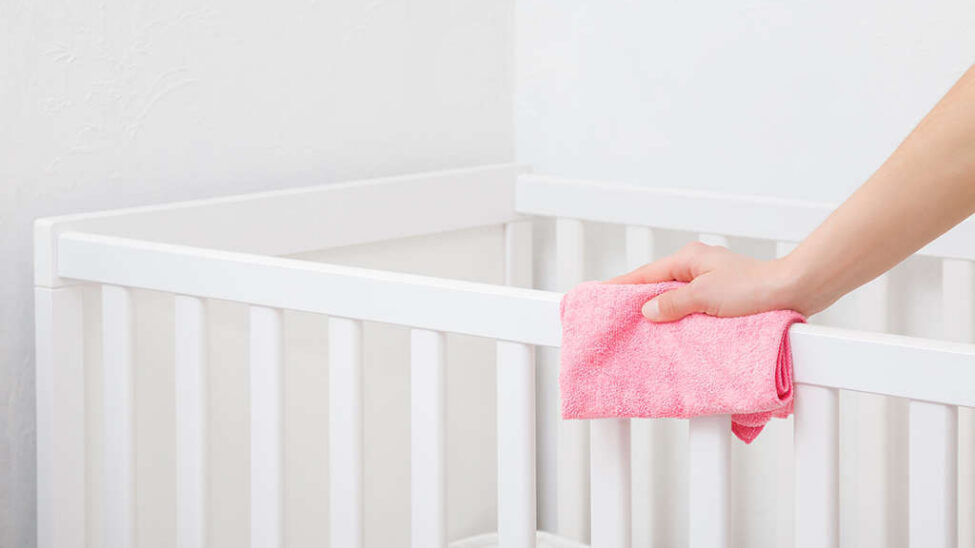
Why Cleanliness Matters More Than We Think
When my son was born, I spent hours picking out the perfect crib. Sleek, safe, stylish. But I completely overlooked one thing: it was a magnet for everything — dust, drool, milk drips, even mysterious crumbs (how?!). And suddenly, cleaning it became just as important as assembling it.
Cleanliness in the crib isn’t just about appearances — it’s about your baby’s health. Babies sleep for the better part of the day, breathing in whatever lingers in their sleep space. That’s why dust, mold, and bacteria aren’t welcome guests.
Even a “clean-looking” crib can hold allergens, dead skin cells, and traces of mildew, especially in humid climates or when accidents aren’t cleaned up quickly.
And while a deep clean once in a while feels satisfying, it’s those tiny regular habits that really make the difference. Think of it as brushing teeth — it’s not the occasional polish, but the daily care that keeps things truly safe and fresh.
What a Weekly Crib Cleaning Really Looks Like
You don’t need to turn into Marie Kondo every Sunday. Realistic crib maintenance can fit into your actual life — yes, even the ones with diaper blowouts and 3 a.m. wakeups. Here’s what I do each week (and honestly, it doesn’t take more than 15 minutes):
- Wipe down the bars with a damp cloth and mild baby-safe detergent
- Check the mattress cover for spit-up or damp spots
- Give the mattress itself a quick air-out if it’s been a sweaty night
- Remove any toys or bumpers that don’t belong (they tend to migrate)
This small routine has saved me from several “oh no, what’s that smell?” moments. And it makes deep cleaning feel way less overwhelming later on.
If your baby is teething, pay attention to the crib rails. I learned this the hard way — my daughter chewed off the paint before I realized she could reach it with her tiny teeth.
Tackling Stains, Odors, and Spills with Confidence
Life with a baby is a beautiful mess — sometimes more mess than beauty. One night, my son had a diaper leak that somehow reached under the mattress. I was horrified. But I also learned how to deal with it, fast.
For fabric stains (like on a crib skirt or mattress protector), I keep a spray bottle with a mix of water, vinegar, and a drop of baby-safe soap. It works on most messes — from milk spills to pee spots — and doesn’t leave behind strong smells.
For wooden surfaces, less is more. Avoid soaking them. A soft cloth and a few drops of baby shampoo diluted in water will do. Let it dry completely before placing bedding back.
Odors can hide in mattress seams. If something smells off and you’ve already washed everything, check the mattress corners or stitching — it’s often the culprit.
And if you’re dealing with persistent smells, sprinkle baking soda on the mattress (with the sheet off), wait an hour, then vacuum it up gently. Works like magic.
Seasonal Deep Cleans Without Losing Your Mind
Every three months, I do what I call a “crib reset.” It’s not about perfection — it’s about starting fresh and knowing your baby’s space is really clean. This usually happens after a growth spurt or sleep regression, when I’m already reorganizing things anyway.
Here’s what I include in my quarterly clean:
- Strip everything: mattress cover, sheets, crib skirt, even that ribbon you forgot you tied there months ago
- Wash all fabrics on hot (if safe for material)
- Vacuum under the crib — not fun, but oh-so-satisfying
- Check for loose screws, creaky joints, or chipped paint
- Wipe down every surface, even the back side of the crib
This is also when I rotate or clean teething rails and inspect the mattress for any signs of sagging or damage.
Don’t forget the legs of the crib — they collect dust faster than the rest, especially if you have pets or an open-window policy.
You’ll thank yourself later during the next sleep regression, knowing at least the crib isn’t part of the problem.
Keeping Everything in Shape Over Time
Caring for a crib isn’t a one-and-done task. It changes as your baby grows. When they start pulling up, I found bite marks on the rail — and when my daughter began standing, I had to adjust the mattress height and rethink where I stored diapers.
Routine matters. A monthly check for wear and tear can prevent bigger issues later. Is the mattress still firm? Are any screws loose? Are parts wobbling when your baby moves? Don’t ignore that subtle shift in stability — that’s how cribs slowly become less safe.
Regular maintenance is less about chores and more about protecting a space your baby spends a third of their life in. Think of it as tuning a piano — small tweaks keep everything harmonious.
Eventually, your crib will transition into a toddler bed, or be passed down. Keeping it clean and safe means it can serve more than one baby — or at least not end up on the curb after just a year.
When Clean Becomes Comfortable
There’s something deeply reassuring about putting your baby to sleep in a space you know is fresh, safe, and ready for dreams. Not perfect — just cared for. That’s what crib maintenance is all about.
It’s not a race to spotless. It’s a rhythm of small, gentle actions that protect what really matters — your baby’s sleep, and your peace of mind.


